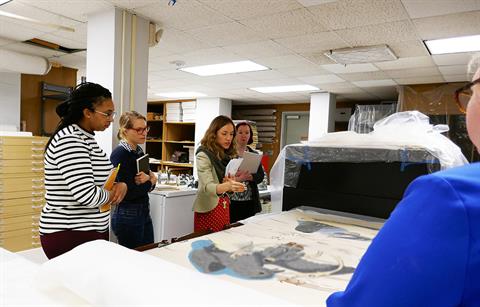
Professor Jessica Horton and students of the curatorial seminar discuss works in the University of Delaware's collection, (L-R Elizabeth Humphrey, Ramey Mize, Jessica Horton, Amanda Zehnder).
September 18, 2018
CURATORIAL COLLECTIVE TO BRING NATIVE ART TO OLD COLLEGE GALLERY
In the 20th century, after the collapse of the fur trade and resettlement due to colonialism, many indigenous communities in Canada and Alaska experienced significant changes to their way of life and had to adjust in order to survive. Both the Inuit people of Nunavut, an Inuit-governed territory in Canada and the Yup’ik people in southwestern Alaska turned to art making not only to establish strong economic standing in these new conditions, but also to instill cultural resilience.
Works including prints; drawings; carved bones, ivory, and stones; and intricately woven grass baskets were made to be sold to global markets—a dynamic that has carried into the present. Many examples of these incredible works are now housed in the permanent Museums Collections of the UD Library, Museums and Press. For the first time since 2002, these works will be the focus of a fall exhibition to be displayed in Old College Gallery.
A student curatorial collective is currently shaping this exhibition as part of a course taught by Dr. Jessica Horton, professor in the Art History Department, with Dr. Amanda Zehnder, chief curator for the Library, Museums and Press, as exhibition curator. Objects on display will include pieces from the Frederick and Lucy S. Herman and the Mabel and Harley McKeague collections of Inuit and Yup’ik art. These collections include an exceptionally strong group of original Inuit drawings and stone sculptures, as well as handwoven Yup’ik grass baskets, ivory and bone carvings, and handmade dolls. Objects on display will range in date from the early 1950s to more contemporary works. They deal with themes around traditional ways of life, changes through resettlement, relationships of reciprocity with animals and the environment, and the challenging conditions of the surrounding arctic.
Titled “The World is Following Its People”: Indigenous Art and Arctic Ecology, the theme of art and environment will run throughout the exhibition. “…Made and collected amid cultural and ecological upheavals during the second half of the 20th century, these works nonetheless convey the continuity of Indigenous ecological knowledge throughout the colonization of the Arctic,” Horton explained. “Their message resonates with added urgency today, as the land and its people stand on the frontlines of global climate change.” The indigenous communities of the arctic region are currently facing massive changes to their environment due to climate change. While we may think of ice caps melting in remote arctic locations, we are prone to forget that these changes immediately affect living, active communities.
To create the exhibition, students are reviewing and selecting objects from the Herman, McKeague, and other collections to display in the exhibition, conducting extensive primary research, and honing in on specific themes and groupings of the works. Beyond the expertise of both Horton and Zehnder, students are also learning from historians and museum professionals who are experts in the field. Class interviews were conducted with Dr. Ann Fienup-Riordan, a prominent scholar in Alaskan Yup’ik culture, who shared her experiences conducting research on the McKeague collections, and Dr. Heather Igloliorte, an Inuk scholar and curator who holds the University Research Chair in Indigenous Art History and Community Engagement at Concordia University in Montreal, Canada.
Both Fienup-Riordan and Igloliorte provided students with crucial perspective and strategies for considerately displaying objects from a culture that they are not from. Zoë Wray, Ph.D. candidate and student in the course, believes this is an important educational opportunity. “Learning how to interpret Native American artworks for a museum exhibition where the audience may have little knowledge of Native culture or art history…is uniquely challenging due to the fraught history of collecting, displaying and interpreting Native objects in Euro-American museums,” she said. In addition to interpreting these materials respectfully, students must also take on language differences to find a balance between maintaining proper representation of Inuit and Yup’ik cultures while adequately communicating these cultures to a predominantly non-native audience.
While the seminar concludes at the end of spring semester, there will still be work to do for the exhibition to open in the fall. Wray has been selected to complete a graduate summer internship through the Museums in order to ensure that the exhibition is installed and executed as the curatorial collective has determined in the course. She will also work on the creation of a website to, as she explained, “serve as a record of the seminar, showing viewers some of the research and issues we were thinking about as we researched the collection and decided how to interpret it.”
"The World is Following Its People" will open September 5, 2018, and continue through December 7, 2018.

